How to create a beautiful container pond to attract wildlife
You can make a container pond out of anything that will hold water.
But some materials are better than others. That includes stone, metal, some ceramics and fibreglass.
Many people also make container ponds out of plastic bowls or buckets. However, plastic gets brittle over time when it’s outside, so it may not last as long. Wooden barrel ponds are also good, provided they’re made of hardwood. Softwoods are more likely to rot.
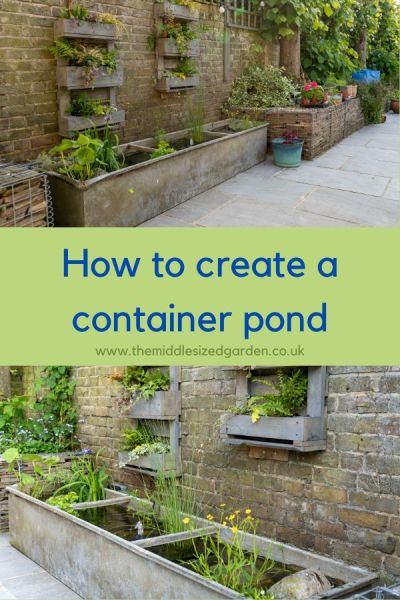
Jane Beedle’s container pond is an old agricultural water trough, given to her by a farmer friend. Jane’s garden is open for Faversham Open Gardens & Garden Market Day on 25th June 2023.
And it’s important to make sure that whatever you choose will withstand the worst your winter can throw at you. You don’t want to find it cracked and broken after an unexpected freeze.
Jane Beedle made her container pond from a galvanized steel agricultural trough. You can buy them new, such as this one from Amazon, but Jane was given a second-hand one by a farming friend.
Note that Amazon links are affiliate, see disclosure.
If you prefer to watch a video, you can see how to make a pot pond on video here.
How deep should a container pond be?
There’s no exact answer but shallow ponds will dry out more quickly in drought, which could damage the plants and wildlife in the pond.
Mosquitoes also breed in shallow water, so if you want to avoid encouraging them, then choose a container which is over 12″ deep. However, if you live somewhere where mosquitoes are a health problem and transmit dangerous diseases, you will probably have local bye-laws or recommendations, so it’s important to check those.
A baby or toddler can drown in very shallow water, so however deep or shallow your mini pond is, make sure that it can’t be accessed by the very young.
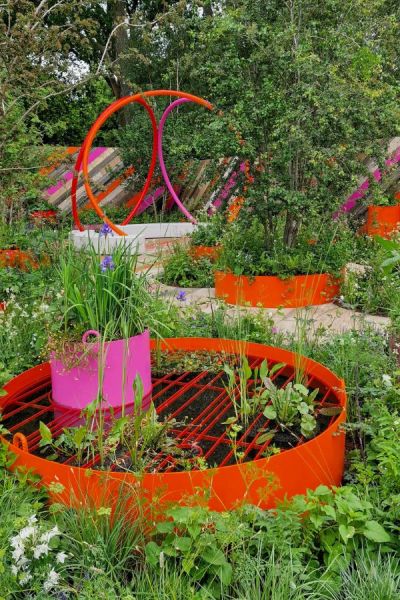
This mini pond at the St Mungo’s show garden at the RHS Chelsea Flower Show 2022 designed by Cityscapes has a grid across the top. It’s a brilliant safety measure – young children can fall in to even the smallest ponds.
Will my mini pond get mosquitoes?
Mosquitoes breed best in shallow, stagnant water. That’s why your pond should really be more than 12″ deep. If you keep the water circulating with a pond pump, that will also help.
Other ways of discouraging mosquitoes include keeping fish in the pond and creating a wildlife friendly garden. Bats, in particular, eat thousands of mosquito a night, so put up a bat box.
Jane really dislikes mosquitoes so she’s putting in a pond pump and getting some fish. I have relied on bat boxes and wildlife friendly strategies. Most of the time that works, although we did get mosquitoes in the very hot spell last summer.
Where to place a container pond?
A mini pond is best is partial sun or shade. It’s better not to put it in either the sunniest or the shadiest part of your garden.
However, you can be reasonably flexible. I created a pond in an oak barrel eight years ago. It’s been in a shady part of the garden, but it’s been fine. It’s been very little work to look after.
It’s important to decide where you are going to place your mini pond before you buy it, because that may affect the shape you choose.
When Jane was thinking about where to place her container pond, she realised that they rarely used a big barbeque on one side of the garden. She therefore knew she would be looking for a long thin shape that would fit into that space.
Position your pond before you start to fill it! You won’t be able to move it once it is full of water.
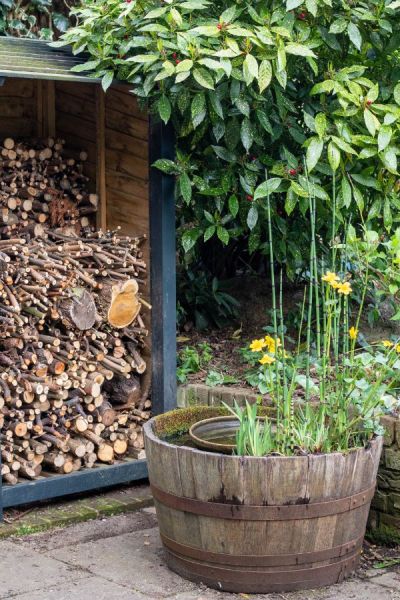
I created this container pond in my own garden eight years ago. It’s in a fairly shady spot but has been fine.
Before you fill your pond with water…
Add a layer of gravel to the bottom, then add rocks, stones or bricks to give you different levels in the water. This helps wildlife to get out of the pond. It also means you can plant a wider variety of pond plants because different aquatic plants need different levels.
Don’t add soil. It adds too many nutrients to the water, which means algae will grow.
Ideally, fill the container pond with water from a rain barrel or water butt. Tap water has chemicals in it.
However, Jane didn’t have access to any rain water, so she filled her trough with a hose. She left it for a few days before planting to allow the chemicals to evaporate off. ‘Don’t use water that’s come through a water softener,’ warns Jane. ‘It’s got too many salts in it.’
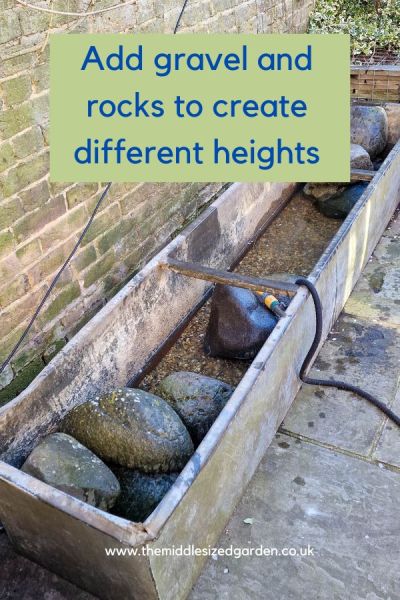
Once you’ve positioned your pond, add a layer of gravel at the bottom and some rocks to create different heights. Jane filled hers with tap water, but rain water is better.
How to plant up a container pond
Most garden centres have an aquatic plants department, but Jane found that choice was quite limited. So she ordered her pond plants online.
Different plants thrive in different levels of water. So when buying plants, check what depth of water they’ll be happy with.
Marginal plants should be planted in shallow water. You can place a brick in the pond, then perch the marginal plant (in its pot) on the brick.
Plants that like deeper water can be placed at the bottom of the pond.
And some plants need to be completely submerged in the water. These include oxygenating plants, which will help keep your water clear. They’re sold in bunches with weights to keep them from floating to the top.
Plant sellers Thompson & Morgan estimate that you need four to five bunches per square metre of surface water. However, they do grow, so if you don’t have enough oxygenating plants, they should fill the space eventually.
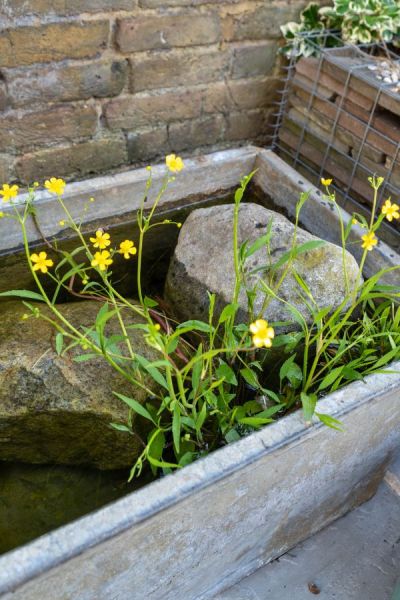
Wedge the pots in between stones or rocks to keep them in place, but check what level of water they need before placing them in the pond.
Do pond plants need compost?
Never use ordinary compost in a pond because the balance of nutrients won’t be right.
You can buy aquatic compost in specialist shops. You would then put the aquatic compost into a special baskets with mesh sides, so the compost doesn’t float around the pond. Plant into the basket.
However, both Jane and I have simply lowered our pond plants into the water in the baskets they came with. They seem to be flourishing.
Jane’s garden is open for Faversham Open Gardens & Garden Market Day 25th June 2023
Jane’s garden is one of 21 gardens open for Faversham Open Gardens & Garden Market on the 25th June 2023. There’s also a delightful Garden Market with plants, antique gardenalia, artworks and more in the historic Market Place.
Faversham is a charming town to visit for a day out. It’s just over an hour from London by train, and has 400+ Listed Buildings, including the finest preserved Medieval street in the UK.
Tickets for the open gardens are £6 or £10 for two (to visit all 21 gardens). They’re available online from the Faversham Society or in the Market Place on June 25th.

Pin to remember how to create a container pond
And do join us. See here to sign up for a free weekly email with more gardening tips, ideas and inspiration.
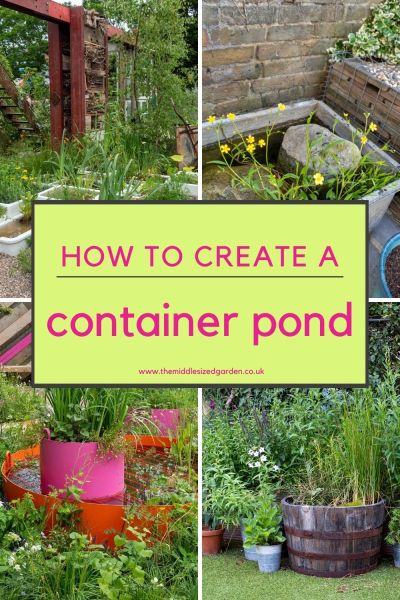
























Hello do the steel troughs like Jane’s have to be lined or coated before being filled with water. Thank you
No, they don’t because this is an agricultural drinking trough, so its main function is to hold water. But it’s a good point, I’ll amend the copy to make this clearer.
Thank you for all your marvellous posts. I do enjoy reading about all the different gardening ideas even if they don’t always apply to my garden. You are very knowledgeable.
Thank you! I always think that it is the people I interview who are so knowledgeable!
Do you have to top the pond up or do you rely on rain water? Thanks for the useful post!
You will have to top it up in extended dry periods. If you have a water butt, you can fill it with rainwater but if you have to use tap water, let the tap water sit in a watering can for 24 hours before adding it to the pond. However, a small bit of tap water straight from the tap won’t hurt.